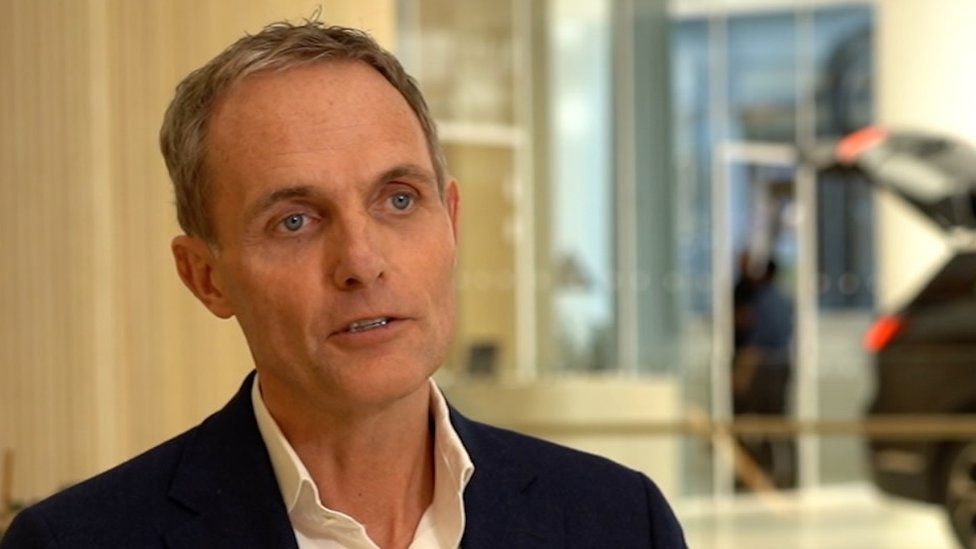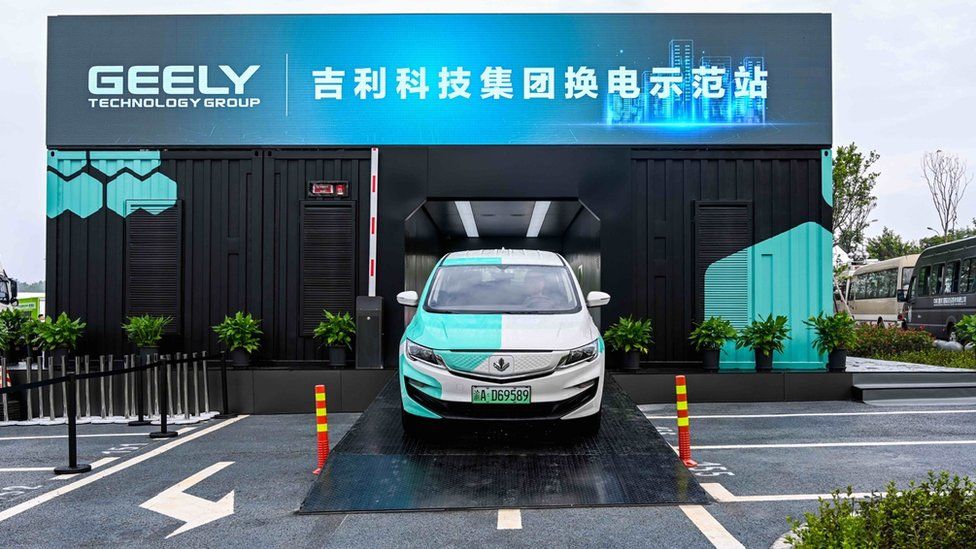International News 116
Will swapping out electric car batteries catch on?
Without even a touch of the steering wheel, the electric car reverses autonomously into the recharging station.
I won’t be plugging it in though, instead, the battery will be swapped for a fresh one, at this facility in Norway belonging to a Chinese electric carmaker, Nio.
The technology is already widespread in China, but the new Power Swap Station, just south of Oslo, is Europe’s first.
The company hopes that swapping out the entire battery will appeal to customers worried about the range of electric cars, or who simply don’t like queuing to recharge.
It was certainly straightforward to book a slot on Nio’s app, and once inside the station, all I have to do is park on the designated markings and wait in the car.
I can hear bolts being undone as the battery is automatically removed from underneath the vehicle and replaced with a fully-charged one.
In less than five minutes, I’m ready to go again.

“You’re not standing outside and taking 30 to 40 minutes [like you do when you recharge]. So it’s more effective,” says Espen Byrjall, Nio’s power and operations manager in Norway.
“There’s no battery degradation. You always get a healthy battery. So, you can keep the cars longer.”
This station can handle up to 240 swaps a day, and the firm plans to create 20 here in Norway.
It’s also partnered with energy giant Shell, to roll them out across Europe, with the aim of installing 1000 by 2025. “It’s going to be a network that lets you drive all over Europe,” says Mr Byrjall.
Alternative strategies
However, from Nio’s flashy showroom in central Oslo, the firm is pursuing a rather different business model – where customers buy the car and lease the battery.
Marius Hayler, the firm’s general manager for Norway and Denmark, says there are several advantages to this approach.
For a start, the customer is not buying the most expensive bit of an electric car – the battery. That knocks around £7,700 ($9,700) off the purchase price.

A buyer then has to factor-in the monthly subscription for the battery, which ranges from £120 to £215, depending on the size of the battery.
But with that cost comes another advantage. “You’re always going to have the newest battery technology,” explains Mr Hayler.
Nio is just one of the latest Chinese arrivals to enter Norway, along with other newcomers like Xpeng, Voyah, and Hongqi, ahead of wider European rollouts.
There are already half a million electric vehicles on the country’s roads and it aims for all new cars to be zero-emission vehicles by 2025.
According to Norway’s Road Traffic Information Council, 83% of all new cars sold from January to March this year were fully electric, while only 6% had diesel or petrol engines.
“Norway has been used as a test market for some time,” says Oeyvind Solberg Thorsen, director of the Norwegian Road Federation lobby group.
“It’s just obvious that the Chinese brands will come here. We have a very favourable set of incentives for electric cars.”

Low taxes on electric vehicles (EVs), widespread charging infrastructure and perks like exemption from tolls, access to bus lanes and free public parking, have all helped Norway achieve the highest rate of EV adoption in the world.
Backed by Chinese tech giant Tencent, Nio sold more than 90,000 cars last year, nearly all of them in China, where it already operates more than 800 battery swapping stations.
Sales in Norway are still in the hundreds, but the newcomer plans to enter Denmark, Sweden, Germany and the Netherlands this year.
Currently, the firm does not share its battery swapping stations with other carmakers but has suggested it would be open to other manufacturers harnessing the technology.
That might help popularise the system further so it really takes off in Europe.
Matthias Schmidt, an analyst from Schmidt Automotive Research, says that such a system could enable smaller and lighter batteries to be used, in turn helping to improve vehicle efficiency.
However, he’s sceptical as to whether battery swaps will be widely adopted in Europe, as fast-charging points are becoming more common.
“The horse has likely already bolted,” he says. “The rollout of a fast-charging network on motorways will be key going forward now.”
But he thinks the technology could be effective for sectors like taxis: “Short downtimes [to recharge] are key for taxis and this could be ideal for the likes of them.”
Although it’s a difficult space to navigate, a decade ago, Israeli firm Better Place launched a similar innovation, but it failed to take off and the business went bankrupt. While, carmaker Tesla also piloted the concept but didn’t pursue it.
Mr Hayler reckons the timing wasn’t right for these firms, saying it was “too early”.
Despite those early failures, other firms are readily employing a battery-swapping model.
Automakers Geely and Aion have recently launched their own systems in China, and battery manufacturer CATL has also developed a facility, called EVOGO.

California start-up, Ample, is working on similar technology, and Honda, Yamaha and Piaggio are also teaming-up to offer switchable batteries for electric motorbikes and light vehicles.
Another benefit, swapping might greatly appeal to customers who can’t easily charge their cars at night.
“In China there are more apartments than you see in Northern Europe. They use the power swap station primarily to recharge the car,” says Mr Hayler.
In Europe, it’s more common to have driveways where home-charging could be installed. So, the swap station might be used mostly to upgrade or downgrade the battery type, Mr Hayler explains. “But we will see.”
Meanwhile, installing battery-swapping infrastructure remains more expensive than charge points. Some people suggest there may eventually be no need to swap batteries at all.
Every year chargers are getting faster and batteries are lasting longer: in April a Mercedes-Benz model drove 1,000km on a single charge.
And even Nio is not betting entirely on battery swaps, it’s also supplying home chargers and installing superchargers on roads too.
Scientists successfully grow plants in soil from The Moon.
Back in 1971, David Bowie asked if there was Life on Mars? Over 50 years later, whilst we might still be a while away from sustainable life on Mars we are a step closer to it on The Moon.
Scientists from the University of Florida have successfully planted cress seeds in soil collected from The Moon by astronauts Neil Armstrong and Buzz Aldrin during the Apollo 11 mission.
The cress seed experiment charted the growth of cress in the soil from The Moon, with soil from Earth as the control. In week one the seeds all sprouted into seedlings, with The Moon cress tracking similarly to the Earth cress.
In the second week, Earth cress surpassed the seedlings grown in the lunar soil, however, their growth still impressed the scientists. Biologist Anna-Lisa Paul said,
“For their first week or so of life, there was really no difference between the controls and the lunar plant, so there wasn’t something inherently toxic to the plants in lunar regolith [soil] that would prevent plants from growing.”
University of Florida geologist Stephen Elardo said. “That was the first step in what will hopefully be a very long, multi-decade process of figuring this stuff out and when we get back to the Moon, doing it on the lunar surface.”

NASA chief, Bill Nelson said, “This research is critical to Nasa’s long-term human exploration goals. We’ll need to use resources found on the Moon and Mars to develop food sources for future astronauts living and operating in deep space.”
War in Ukraine: More coverage
The Red Square Victory Day parade is about aesthetics too, and military hardware in particular. It is a chance for the Kremlin to show off its latest weaponry.
It was the Armata T-14 tank that turned heads on Victory Day in 2015, but it has been conspicuous by its absence in the war in Ukraine, because it is not yet ready for frontline combat. Ukraine says it has destroyed well over 1,000 less modern Russian tanks on the battlefield.
There will be less hardware and fewer troops this year than in 2021. But there will still be some 10,000 troops and 129 pieces of military equipment, according to an analysis by BBC Russian. Gone will be one of Russia’s newest tanks, the T-80BVM, as well as the Pantsir-S1 anti-aircraft missile system.
The aerial display will be just as big as before, with 77 planes and helicopters, and the air force has been rehearsing over Red Square in a Z-formation – the controversial symbol adopted by invading forces.
But there will be no foreign leaders this year, which the Kremlin puts down to the 77th anniversary not being a significant event in itself.
Most of the messaging around Victory Day is directed at the Russian population anyway, says Olga Irisova. By harnessing the Nazi narrative from World War Two, the Kremlin is able to stir up strong feelings because most Russians have relatives who either died or struggled in the war.
While events will take place across Russia, in neighbouring countries 9 May has become less and less significant. Ukraine saw some of the greatest losses in the war and a recent opinion poll suggested that the date should be seen as a day of remembrance rather than victory.
Kazakhstan has cancelled its military parade for a third year running and Latvia has declared it a day of remembrance – for victims of Russia’s war in Ukraine.
Why 9 May Victory Day is so important for Russia
It has become an annual event – the military parade in Red Square in Moscow and cities across Russia on 9 May, marking victory over Nazi Germany in 1945.
Under Vladimir Putin, Victory Day has become a show of strength of troops and military hardware, as well as a chance to remember the sacrifices of World War Two. Twenty-seven million Soviet citizens died, by far the greatest loss of any country, in what Russians call the Great Patriotic War.
This year, the event has taken on a significance of its own. Far from liberating Europe, Russia has waged months of war against its neighbour Ukraine and is devoid of any real form of military victory that it can celebrate.
Regiments that played a key role in the war will parade in front of the top brass and the president, whose address will echo across Red Square and be scrutinised for what to expect next. Russia’s leader often uses this moment to send messages of intent.
The Victory Day parade was occasionally marked in the Soviet era and revived by President Boris Yeltsin for the 50th anniversary in 1995, but it was Vladimir Putin in 2008 who made it an annual event featuring military hardware. Russian identity has been largely created with Victory Day in the background, with schoolbooks and history books focusing on Russia as Europe’s wartime liberators.
“Even in a normal year it’s a huge show of Russia strength, of Putin’s control and everything he stands for,” says Ammon Cheskin of Glasgow University. “And that’s just amplified this year.”
Claims that he will declare an end to the campaign have been denied, as have reports that he will announce a full declaration of war or a mobilisation of Russian men. Russia’s military would not “artificially adjust” its actions to any particular date, said Foreign Minister Sergei Lavrov.
Something short of full mobilisation could be announced, in response to Russia’s big losses on the battlefield. Dozens of ads have appeared on job websites in recent weeks looking for “specialists in mobilisation work”, but such a step could hit the president’s popularity and 9 May might not be the right time to announce it.
After Russia annexed Crimea in 2014, Vladimir Putin marked Victory Day with a speech in Red Square about defeating fascism, before flying to the Black Sea port of Sevastopol to celebrate his new victory in front of thousands of onlookers.

“This year the primary objective was to announce the victory that was supposed to happen in February,” says Ernest Wyciszkiewicz of the Centre for Polish-Russian Dialogue and Understanding. “They are preparing a PR stunt for Monday: it’s important for Russians to see that the special military operation they have been hearing about has led to something tangible.”
Instead of celebrating the overthrow of Ukraine’s government, the Kremlin will have to settle for the capture of most of Mariupol. The city may lie in ruins, but Russia has repeatedly talked of “de-Nazification and demilitarisation” of Ukraine and it may claim defeat of the Azov battalion, which it has falsely portrayed as Nazi. That would resonate on a day marking World War Two.
“In Russian cities and regional capitals we can see signs with the Victory Day symbol,” says Olga Irisova, co-founder of analysis group Riddle Russia. “Usually the signs say 9 May 1945 but this year it’s 1945/2022, so they’re trying to provide people with the idea that once again they’re standing up to Nazis.”
In Mariupol itself there will be no Victory Day parade because of apparent security threats. Russia’s proxy leader in the region, Denis Pushilin, has said a parade will have to wait until Mariupol becomes part of his so-called Donetsk People’s Republic.
There will be unspecified festive events, though, and it could feature prominently in Russian coverage. In the run-up to 9 May the city has had visits from Kremlin TV spin doctor Vladimir Solovyov and a delegation from the Kremlin led by the president’s deputy chief of staff, Sergei Kiryenko.
Social media activity shows Johnny Depp gaining sympathy in case against Amber Heard
Johnny Depp’s Instagram account has seen a sharp rise in followers since he started appearing in a court in a case involving his former wife Amber Heard.
On May 1, the actor was being followed by 14.8 million people on the photo and video-sharing website. The number of his followers rose to 15.2 million on May 4. Interestingly, Depp did not share anything on his Instagram during that period.
The Pirates of the Caribbean star, 58, issued Heard, 35, for defamation after she accused him of abuse.
Depp has accused Heard, also an actor, of defaming him when she penned a December 2018 opinion piece in The Washington Post about being a survivor of domestic abuse.
A state court judge in Fairfax County, Virginia, is overseeing the trial, which is in its second week and is expected to last six weeks
Johnny Depp trial – live: Amber Heard op-ed was ‘catastrophic’ for Pirates actor’s career, agent says
The trial of Johnny Depp’s defamation lawsuit against Amber Heard has entered its fourth week in Fairfax, Virginia.
Heard is being sued by Depp for $50m (£38.2m) for implying he abused her in a 2018 Washington Post op-ed. Although she did not name him, he claims her allegations made it difficult for him to land movie roles.
In testimony on Monday, the jury heard from Depp’s security guard Travis McGivern who was present for two fights between the couple at their Los Angeles penthouse, including one in which he claims Heard punched, Depp.
The actor’s agent, Jack Whigham, told the court about Depp’s career leading up to and following the publication of the op-ed, describing it as “catastrophic”. He said Depp had lost his role in the sixth Pirates of the Caribbean movie, and he was unable to sign any studio productions in the years that followed.
Further testimony was given by a nurse employed by Heard who said she was prone to outbursts of rage and described apparent injuries after the couple had allegedly fought.
Heard is yet to testify and provide her own account of the relationship, but is expected to take the stand on either Tuesday or Wednesday.
Categories
- Breaking News (148)
- buisness (21)
- Entertainment (108)
- Box Office (13)
- Gaming (10)
- Marvel (MCU) (8)
- Movies (24)
- DC (DCU) (3)
- Netflix Series (2)
- Series (6)
- Enviornment (8)
- Fashion (96)
- Men's Fashion (3)
- Women's Style (3)
- Food (13)
- Health & Fitness (9)
- History (1)
- Hollywood Gossip (3)
- Home & Garden (3)
- International News (116)
- Lifehacks (21)
- Literature (30)
- Local News (75)
- Modeling (1)
- Music (8)
- Politics (10)
- Science (37)
- Psychology (2)
- Social (3)
- Sports (106)
- Technology (31)
- Traveling (70)
- Uncategorized (64)
- Vehicles (136)
Ask Your Problems
-
About Leasing
7 years, 1 month ago
-
About Vehicles
7 years, 1 month ago












Most commented